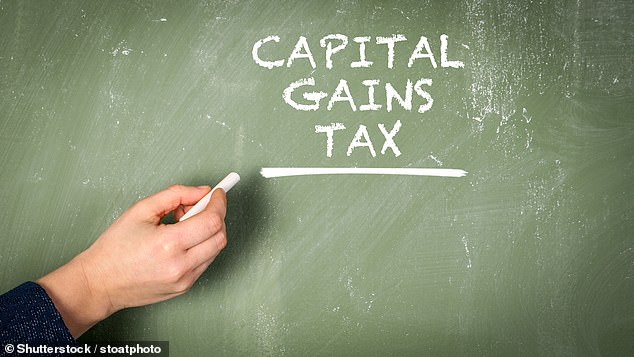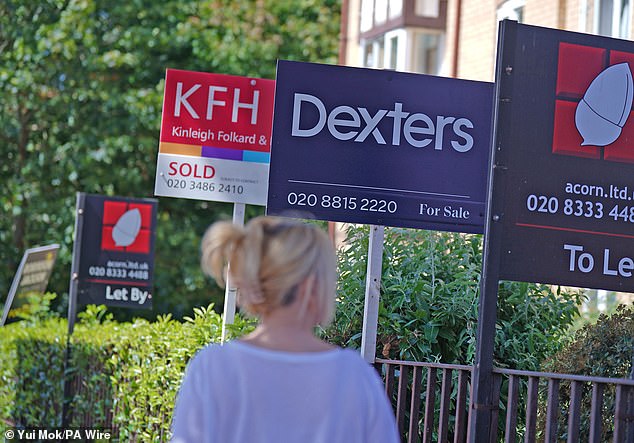Capital gains tax is levied on profits from assets ranging from shares to second homes, buy-to-let properties and personal possessions.
The rates for stocks and shares gains were hiked in the Autumn Budget from 10 per cent to 18 per cent for basic rate taxpayers and from 24 per cent from 20 per cent for those paying higher rates of tax.
The move brought them into line with the already higher levies on property gains and took effect immediately.

The rises are expected to raise an extra £2.5billion to help address a £22billion ‘black hole’ in the country’s finances.
HMRC figures show that 369,000 people paid capital gains tax in the 2022/2023 tax year, raising £14.4billion for Treasury coffers – but this dates from when the £3,000 CGT annual allowance was more than four times higher.
Traditionally, CGT rates are applied at lower rates than income tax, because profits tend to come from people taking a risk – whether an entrepreneurial one or an investment one.
Employment income and savings interest are more guaranteed, and so taxed differently and more heavily. We explain what you need to know about capital gains tax.
What is capital gains tax?
Capital gains tax, known as CGT, is levied on profits on assets including stocks and shares, second homes, buy-to-lets and some personal possessions.
There is an annual capital gains tax-free allowance of £3,000 and the tax is charged on profits above this.
Losses on the sale of investments can be deducted from gains on others.
Profits are defined as the difference between the price paid plus costs and the sold price. There are different rates depending on an individual’s tax bracket and the type of asset sold.
Your main home that you live in, known as your Principal Private Residence, is exempt from CGT.
The annual capital gains tax-free allowance was £12,300 until April 2023, which meant CGT was typically levied on wealthier taxpayers. However, radical cuts to the CGT allowance – to £6,000 in spring 2023 and £3,000 from April 2024 – make it inevitable that many more people will now have to pay capital gains tax.
Capital gains tax rates
Capital gains tax is paid on the profits when you sell an asset – what it sells for, less what you paid for it or it was worth when acquired.
Depending on the asset there are reliefs available and each person has a capital gains tax allowance, which is currently £3,000, to offset against their gains.
Following the changes in the Budget, basic rate taxpayers pay 18 per cent CGT, while higher and additional rate taxpayers pay 24 per cent.
There is a separate rate for entrepreneurs selling businesses. Business Asset Disposal Relief means they pay tax at 10 per cent on all gains on qualifying assets up to £1million at present.
But this rate will rise to 14 per cent in April 2025 and then to 16 per cent in April 2026.
Although capital gains and income tax are separate, profits are added to other income to decide the rate paid. That means that a big profit can drag a basic rate income taxpayer over the £50,270 threshold and into the higher rate capital gains tax band.
Investments in an Isa or pension are not subject to capital gains tax.
What if you are given or inherit an asset?
‘If an asset was transferred to you as a gift, then the value at transfer will be the valuation for acquisition,’ says This is Money’s tax expert Heather Rogers.
‘When the asset is left to you through a will, then the probate value will be the value you are deemed to have acquired it for.’
Rogers adds: ‘You can deduct costs of acquisition and disposal if relevant – the estate agent’s and solicitor’s fees on sale, for example. You can also deduct costs where you have spent money and have added value to the asset.’
The Government has more information on CGT rates here.
Rogers explains how to carry forward capital losses to offset them against capital gains here.
And she looks at which types of personal possessions, referred to in this context as ‘chattels’, are liable for CGT and which are exempt here.
How to protect against capital gains tax
Investing inside an Isa or pension can protect you from capital gains tax on profits.
To protect your investments, the key is to ensure that they are inside a stocks and shares Isa wrapper to shield them from CGT, or to potentially hold them within a self invested personal pension.
Pension funds cannot be accessed until at least 55 though, and that age is due to rise overnight to 57 on 6 April 2028.
There are specific capital gains tax rules that say you cannot sell investments to cash in a profit and then buy the same ones straight back. Instead, investors must wait 30 days or they will lose any tax benefit. An exception is allowed for those selling and buying the same investments back within an Isa or Sipp.
This means that many investors looking to cash in some gains and avoid capital gains tax problems down the line do something called a Bed and Isa.
This involves selling investments to crystallise a gain and capital gains tax liability and then buying them back within a stocks and shares Isa.
It is also possible to pass investments between spouses free of CGT, so married couples and civil partners can transfer assets before selling them to take advantage of both their capital gains tax allowances.

Buy-to-let and CGT
When you come to sell your buy-to-let property, there will be capital gains tax to pay on any profit.
It applies to any property which is not your main home – your Principal Private Residence – including private second homes as well.
CGT is levied at the rates explained above, but as gains are added to income to deliver a total amount this means that in practice most landlords making decent profits should pay the higher 24 per cent rate.
There are two reliefs you can get on your CGT bill, but they are both less generous than they once were.
First, there is a capital gains tax regime specifically for ‘accidental’ landlords, who once lived in a property before going on to let it out.
If a landlord rents out a property that was once their main home, capital gains tax only applies on the amount the home went up in value while they weren’t living there.
Landlords can also add an extra nine months onto the amount of time they lived at the property – this is known as the ‘final period exemption’.
As an example of how this works, a landlord who has owned their property for 10 years and lived in it for two would be taxed on seven years and three months of capital gains – the 10 years, minus the two years residency plus the reduced nine months’ relief.
Another key CGT allowance to be aware of is ‘lettings relief’.
When a landlord sells their former home after renting it out, up to £40,000 of their gain can be exempted from capital gains tax – but this now applies only if they lived in the property with their tenants.
Meanwhile, you can reduce your CGT bill by deducting some of the expenses associated with buying and managing a property.
You may also be able to offset losses on other property against your capital gains tax bill.
DIY INVESTING PLATFORMS
Affiliate links: If you take out a product This is Money may earn a commission. These deals are chosen by our editorial team, as we think they are worth highlighting. This does not affect our editorial independence.



